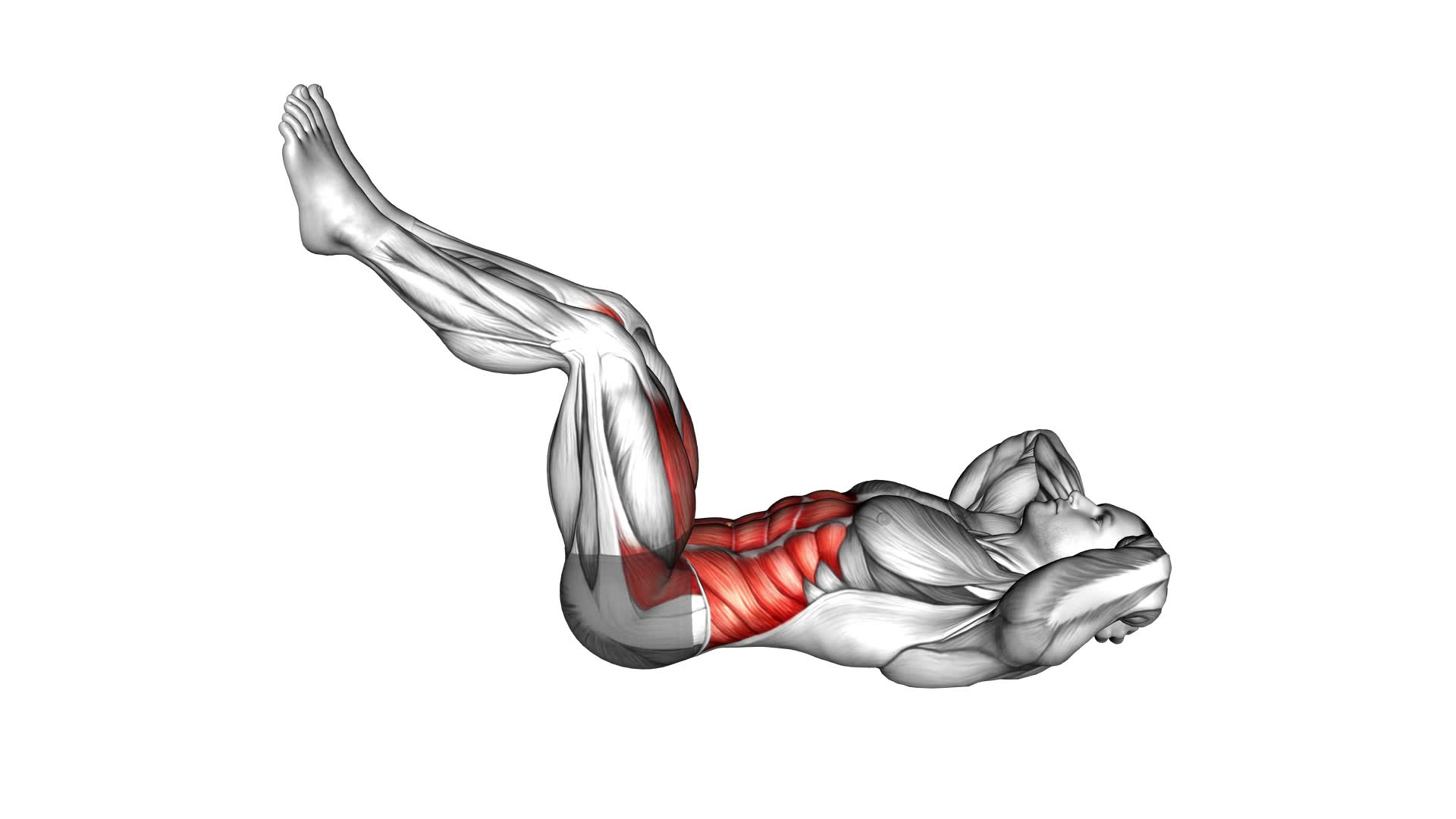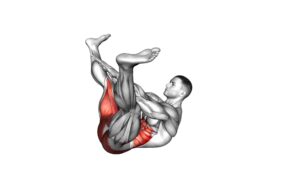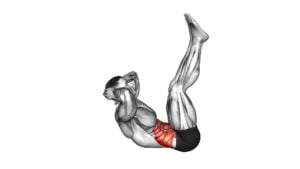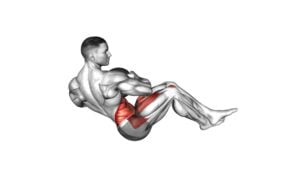Twist Crunch (Legs-up) (male) – Video Exercise Guide & Tips

Looking to target your abdominal muscles? The Twist Crunch (Legs-up) exercise is perfect for you! This video exercise guide and tips will show you the proper form and technique to get the most out of this workout.
Watch This Exercise Video
Whether you're a beginner or an experienced individual, there are modifications and advanced variations to suit your fitness level. Maximize your results with these helpful tips.
Let's get those abs working!
Key Takeaways
- The Twist Crunch (Legs-up) exercise is highly effective in improving core strength and targeting the lower abdominal muscles.
- Beginners can modify the exercise by keeping their feet on the ground, performing with bent knees, and gradually building strength.
- Proper form, technique, and equipment are important to reduce the risk of injury and maximize the benefits of the exercise.
- Advanced variations of the Twist Crunch (Legs-up) can be performed by experienced individuals, but it is important to follow safety guidelines and listen to your body.
Benefits of the Twist Crunch (Legs-up) Exercise
You can frequently reap the benefits of the Twist Crunch (Legs-up) exercise. This exercise is highly effective in improving core strength and targeting the lower abdominal muscles. By engaging in this exercise regularly, you can see significant improvements in your overall core stability and muscular endurance.
The Twist Crunch (Legs-up) exercise specifically targets the muscles in your lower abdomen, including the rectus abdominis and obliques. By twisting your torso and lifting your legs off the ground, you create a challenging movement that activates these muscles to a greater degree than traditional crunches.
In addition to strengthening your core, this exercise also helps to improve your balance and coordination. The twisting motion engages your obliques, which play a crucial role in stabilizing your body during rotational movements.
To get the most out of this exercise, it's important to maintain proper form and technique. This will ensure that you're effectively targeting the intended muscles and reducing the risk of injury. Let's now move on to discuss the proper form and technique for performing the Twist Crunch (Legs-up) exercise.
Proper Form and Technique
Maintaining proper form and technique is essential for maximizing the benefits of the Twist Crunch (Legs-up) exercise and minimizing the risk of injury. To ensure you're performing the exercise correctly, keep the following tips in mind:
- Keep your lower back pressed against the floor: One common mistake is allowing your lower back to lift off the floor during the movement. By keeping your lower back firmly pressed against the floor, you engage your abdominal muscles more effectively.
- Control the movement: Avoid using momentum to swing your legs up and down. Instead, focus on controlled movements, engaging your core muscles throughout the exercise.
- Breathe properly: It's important to exhale as you crunch up and inhale as you lower your legs. This helps stabilize your core and maintain proper form.
- Avoid pulling on your neck: Many people have the misconception that pulling on their neck will help them perform the exercise better. However, this can strain your neck muscles and lead to injury. Instead, place your hands lightly behind your head for support, but avoid pulling on your neck.
Equipment and Preparation
To properly prepare for the Twist Crunch (Legs-up) exercise, ensure that you have the necessary equipment and are ready to begin.
Before starting any workout, it's important to warm up your body to prevent injury and maximize performance. Warm up exercises increase blood flow to your muscles, improve flexibility, and prepare your body for the upcoming workout. Some benefits of warm up exercises include reducing muscle stiffness, enhancing joint mobility, and increasing the effectiveness of your workout.
When it comes to equipment, the Twist Crunch (Legs-up) exercise can be done at home with minimal equipment. All you need is a comfortable mat or exercise mat to provide support and cushioning for your back. This will help prevent discomfort and protect your spine during the exercise. Additionally, you may want to have a towel or water bottle nearby to stay hydrated throughout your workout.
By ensuring you have the necessary equipment and properly warming up your body, you can safely and effectively perform the Twist Crunch (Legs-up) exercise. Remember to listen to your body, start slowly, and gradually increase the intensity of your workout over time.
With consistency and dedication, you can achieve your fitness goals from the comfort of your own home.
Modifications for Beginners
If you're new to the Twist Crunch exercise, there are a few modifications you can try to make it easier.
One option is to keep your feet on the ground instead of raising them up.
Another option is to perform the exercise with bent knees instead of straight legs.
These modifications will help you gradually build strength and progress towards the full Twist Crunch.
Easier Variations for Beginners
Start with simpler variations to gradually build strength and avoid strain when performing the Twist Crunch (Legs-up) exercise. Here are four beginner modifications that can help you progress effectively:
- Feet on the ground: Keep your feet flat on the floor instead of raising them up. This reduces the intensity of the exercise and allows you to focus on engaging your core muscles.
- Bent knees: Instead of straightening your legs, bend your knees and bring them closer to your chest. This modification reduces the strain on your lower back and makes it easier to perform the crunch.
- Arm support: Place your hands behind your head or on the floor for added support. This helps to stabilize your upper body and makes it easier to maintain proper form.
- Decreased range of motion: Instead of twisting your torso all the way to the side, start with smaller twists. Gradually increase the range of motion as your core strength improves.
Gradual Progressions for Beginners
As you continue your fitness journey, you can gradually progress from the easier variations discussed previously to more challenging modifications for beginners.
To ensure a smooth transition, it's important to use proper progression techniques and avoid common mistakes.
One effective progression technique is to increase the number of repetitions or sets gradually. For example, you can start with 10 reps of the twist crunch (legs-up) exercise and gradually increase it to 15 or 20 reps over time.
Another technique is to add resistance by holding a weight or using resistance bands. This will help you build strength and endurance.
Additionally, focusing on maintaining proper form and avoiding common mistakes such as using momentum or pulling on the neck will help you get the most out of your workouts.
Remember to listen to your body and progress at a pace that feels challenging but manageable.
Advanced Variations for Experienced Individuals
Now that you have mastered the basic twist crunch (legs-up) exercise, it's time to take it to the next level with advanced variations.
These variations offer additional benefits and challenges for experienced individuals. By incorporating modifications and following safety guidelines, you can continue to push yourself and achieve even greater results in your fitness journey.
Benefits of Modifications
Take your workout to the next level with advanced variations that are designed for experienced individuals seeking additional benefits. These modifications not only challenge your body in new ways but also provide increased flexibility and core strength.
Here are four benefits of incorporating advanced variations into your exercise routine:
- Enhanced flexibility: Advanced variations require a greater range of motion, helping to improve flexibility in your muscles and joints.
- Increased core strength: These modifications engage your core muscles to a higher degree, leading to a stronger and more stable core.
- Greater muscle activation: Advanced variations target specific muscle groups more intensely, leading to increased muscle activation and growth.
- Improved balance and coordination: By challenging your body with complex movements, advanced variations help improve your overall balance and coordination.
By incorporating these advanced variations into your workout routine, you can experience these additional benefits while taking your fitness journey to new heights.
Now, let's move on to the next section, where we'll discuss important safety guidelines for performing these variations.
Safety Guidelines for Variations
To ensure your safety while performing advanced variations, it's important to follow these guidelines.
First and foremost, always warm up before attempting any advanced variations. This will help prepare your body for the intense movements and reduce the risk of injury.
Common mistakes to avoid include using momentum to perform the exercise, which can strain your back and neck. Instead, focus on engaging your core muscles and using controlled movements.
It's also crucial to maintain proper form throughout the exercise. Keep your back flat on the ground and your neck relaxed.
Tips for Maximizing Your Workout Results
Achieve optimal results in your workout by implementing key strategies. To maximize your workout results, be sure to avoid common mistakes and follow the recommended workout duration. Here are four tips to help you get the most out of your fitness routine:
- Proper form: It's essential to maintain proper form during exercises. Pay attention to your posture, alignment, and technique to ensure you're targeting the right muscles and minimizing the risk of injury.
- Progressive overload: Gradually increase the intensity of your workouts over time. This could be achieved by adding more weight, increasing the number of repetitions, or reducing rest time between sets. By challenging your body progressively, you'll continue to see improvements in strength and endurance.
- Balanced diet: Remember that exercise alone isn't enough to achieve your fitness goals. Pair your workouts with a balanced diet that includes a variety of nutrient-rich foods. This will provide your body with the fuel it needs to perform at its best and aid in recovery.
- Consistency: Consistency is key when it comes to seeing results. Stick to a regular workout schedule and make it a priority in your daily routine. By staying consistent, you'll build momentum, develop healthy habits, and ultimately achieve your desired fitness goals.
Frequently Asked Questions
How Many Calories Does the Twist Crunch (Legs-Up) Exercise Burn?
The twist crunch (legs-up) exercise is a great way to burn calories and strengthen your core muscles. By twisting your torso and lifting your legs, you engage multiple muscle groups, increasing the intensity of the workout.
To maximize calorie burn, focus on maintaining proper form throughout the exercise. Keep your back straight, engage your abs, and exhale as you twist.
With consistent practice, this exercise can help you achieve your fitness goals.
Can the Twist Crunch (Legs-Up) Exercise Help in Reducing Belly Fat?
Yes, the twist crunch (legs-up) exercise can help in reducing belly fat. However, it's important to note that spot reduction isn't possible.
To effectively reduce belly fat, you need to incorporate a combination of regular exercise and dietary considerations. This includes a balanced diet, portion control, and reducing overall calorie intake.
Additionally, there are alternative exercises that can also target belly fat, such as planks, Russian twists, and bicycle crunches.
Is It Safe to Perform the Twist Crunch (Legs-Up) Exercise if I Have a Lower Back Injury?
If you have a lower back injury, it may not be safe to perform the twist crunch (legs-up) exercise. It puts strain on the lower back and could exacerbate your injury.
Instead, consider trying alternative exercises that are gentler on the lower back, such as planks, bird dogs, or pelvic tilts.
Always consult with a healthcare professional before starting any new exercise routine, especially if you have a pre-existing injury.
How Often Should I Do the Twist Crunch (Legs-Up) Exercise to See Noticeable Results?
To see noticeable results from the twist crunch (legs-up) exercise, it's important to be consistent. Aim to do this exercise three to four times a week.
Rest for about 30 seconds to a minute between sets of the twist crunch (legs-up) exercise. This will allow your muscles to recover and prevent overexertion.
Additionally, there are variations of the twist crunch (legs-up) exercise that you can try to target different areas of your abs and add variety to your workout routine.
Are There Any Specific Breathing Techniques to Follow While Doing the Twist Crunch (Legs-Up) Exercise?
When doing the twist crunch (legs-up) exercise, it's important to focus on your breathing. By exhaling as you twist and crunch, you engage your core muscles more effectively. Inhale as you lower your body back down to the starting position. This breathing technique helps to maintain control and stability throughout the exercise.
Additionally, be sure to avoid common mistakes like using momentum or pulling on your neck. Keep your movements slow and controlled for optimal results.
Conclusion
Incorporating the twist crunch (legs-up) exercise into your fitness routine can provide numerous benefits, including improved core strength and stability. By maintaining proper form and technique, using the right equipment, and making modifications as needed, individuals of all fitness levels can safely perform this exercise.
For those looking to challenge themselves, there are advanced variations available. Remember to always prioritize safety and consult a professional before starting any new exercise routine.

Author
Years ago, the spark of my life’s passion ignited in my mind the moment I stepped into the local gym for the first time. The inaugural bead of perspiration, the initial endeavor, the very first surge of endorphins, and a sense of pride that washed over me post-workout marked the beginning of my deep-seated interest in strength sports, fitness, and sports nutrition. This very curiosity blossomed rapidly into a profound fascination, propelling me to earn a Master’s degree in Physical Education from the Academy of Physical Education in Krakow, followed by a Sports Manager diploma from the Jagiellonian University. My journey of growth led me to gain more specialized qualifications, such as being a certified personal trainer with a focus on sports dietetics, a lifeguard, and an instructor for wellness and corrective gymnastics. Theoretical knowledge paired seamlessly with practical experience, reinforcing my belief that the transformation of individuals under my guidance was also a reflection of my personal growth. This belief holds true even today. Each day, I strive to push the boundaries and explore new realms. These realms gently elevate me to greater heights. The unique combination of passion for my field and the continuous quest for growth fuels my drive to break new ground.







